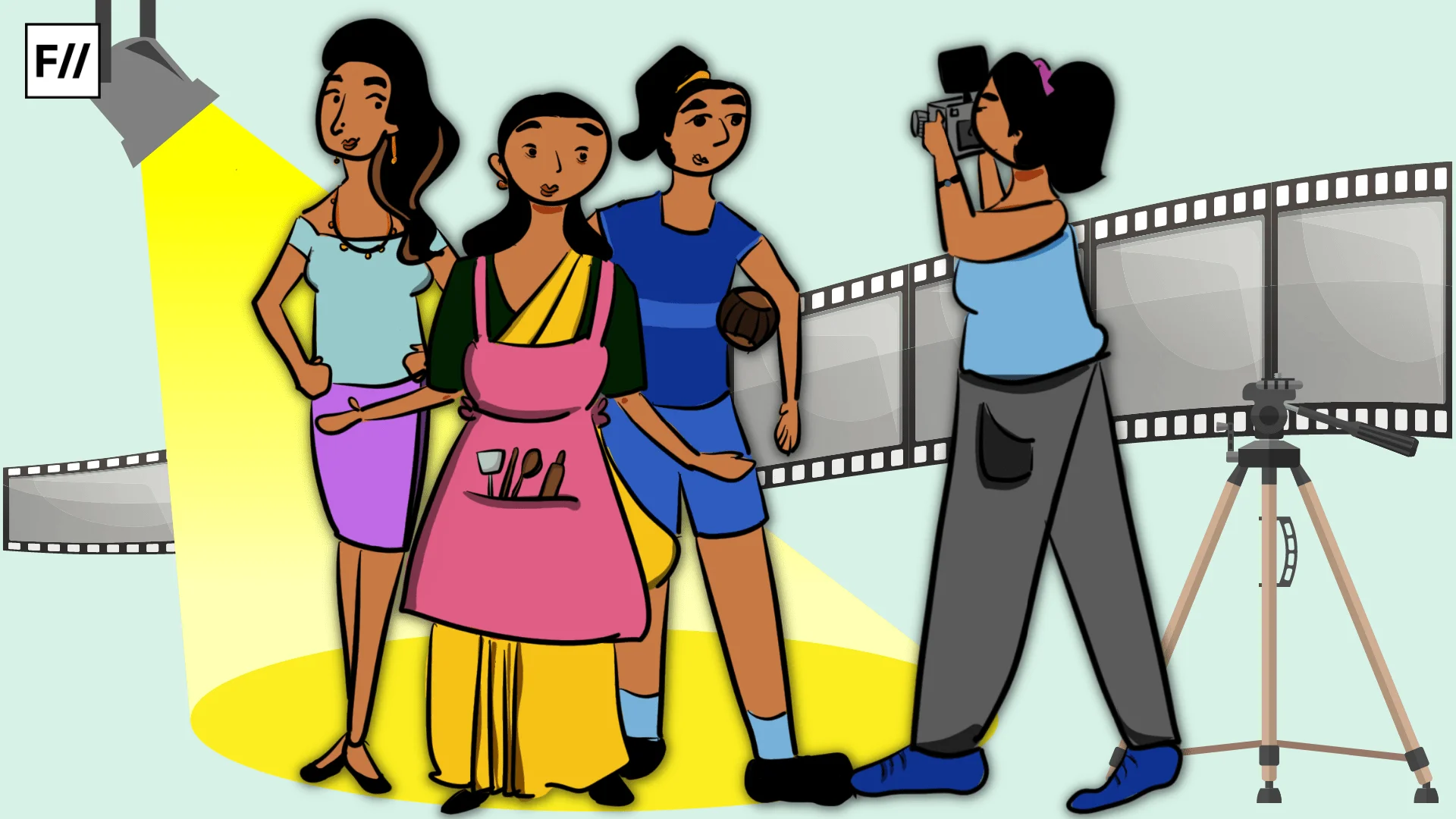Let me start by telling you something.
On a Tuesday morning last month, unable to sleep – the foundational reason for doomscrolling – I found myself watching a woman perfectly dressed in a neatly pressed Kanjeevaram saree. At first, it felt like just another reel, so I stayed on. From simply glancing at the video, I could tell that she is in Bombay, in a spotless kitchen. The caption on the video said, “5 AM morning routine of a housewife”; it had 2.3 million views. I watched the video multiple times. She performed a puja, she prepared an elaborate breakfast thali, and she packed her husband’s lunch. All the cuts, edits and filters ensured that her video was perfectly engineered for maximum algorithmic reach.
At the end of the caption, I note three sponsored tags: kitchen appliances, traditional wear, and wellness supplements. All the items she seamlessly integrated into the reel. My first thought: she was paid for performing patriarchy. Naturally, I wandered over to the comments section, and I realised this is not a story about capitalism. It is a story about women. Under the layers of choice, tradition and technology, it is all, honestly, about efficient forms of subordination.
The premise: freedom or monetised chains?
The premise is this: the twenty-first century has reached a point where women are being freed from years of unpaid labour and traditional domestic chores. However, when Silicon Valley enters the scene and offers the possibility of turning domestic tasks into a profitable venture, women who wish to grow, despite facing disadvantages, will be foolish not to pursue it. Platforms like Instagram and YouTube are now seeing a strange trend. Educated and privileged women curate elaborate displays of domesticity, masked under the pretext of choice feminism – that feminism is all about empowering women and their choices. Their videos are deliberate and of such good quality, with perfectly kept kitchens and brass and copperware décor with the right amount of kitchen plants, that they pose as rivals for major film productions.
Platform capitalism operates on a seemingly straightforward principle. Engagement will always equal revenue. The algorithm stays far from concerning itself with gender equality and oppression. It concerns itself with watch time, comments, shares and the emotional dependence users cultivate to keep scrolling.
This trend arguably rose post the western “tradwife” movement, where white women in prairie dresses bake sourdough and praise the virtues of 1950s gender roles, despite the movement garnering criticism for being a reactionary fantasy and allowing women to cast webs of escape from feminism by women who can afford to refuse economic responsibilities. But when this trend moves to India, it takes on a darker meaning because it is no longer a nostalgic longing for roles women dreamt of abandoning but a technological intensification of roles that they could never really leave.
The profitability of patriarchy
Platform capitalism operates on a seemingly straightforward principle. Engagement will always equal revenue. The algorithm stays far from concerning itself with gender equality and oppression. It concerns itself with watch time, comments, shares and the emotional dependence users cultivate to keep scrolling. Clocked in the language of choice, empowerment and tradition, this form of engagement is built on reaffirming social hierarchies. We can safely assume this because a woman demonstrating “20 ways to please your husband with your cooking skills” is likely to garner hundreds of views, and a video of a woman reporting sexual abuse or mental health issues is likely to be banned, as reported by many feminist content creators. Thus, the message is clear. Patriarchy pays.

This message, though, is no surprise. Platform algorithms, by design, are trained on data reflecting centuries of patriarchal preferences. They have learnt that women’s bodies, when shown a certain way, generate clicks, that traditional gender roles ease regressive attitudes for mass audiences and that controversies and subjecting women’s actions to the public for opinion drive engagement. The algorithm crowns itself as a patriarch of sorts, choosing to reward women for their subordination and to accordingly punish them if they show any form of resistance.
Indian tradwife creators have walked across the tightrope of imaginary freedom and have ultimately mastered a lesson. If they cannot break free from the shackles of promised freedom from unpaid labour, they can at least recognise that the algorithm prefers aspirational femininity and express it through acts of service. They put their years of unpaid labour on display in the hopes of spreading a wave of validation. Maybe, just maybe, if this educated woman opts to prioritise her husband’s preferences, surely, it must be okay that they do the same? Surely their exhaustion means devotion? Surely it is not another form of oppression and is just about practice preservation? These questions transform doubts into dupes. They paint an illusion of remaining in control and having control.
The implications of choice feminism, a.k.a. masked violence
The defence of tradwife content, like I noted above, consistently references the idea of choice. That is, feminism is all about empowering women and their choices. Who are we to judge their agency? Feminism is all about supporting other women, no matter what they choose to do. Yet, choice removed from context leads to a neoliberal fantasy. In a country where women’s workforce participation fell to 24 percent at one point (one of the lowest worldwide), where domestic violence and dowry deaths still cover three-fourths of a page in the newspaper, where a child still needs a father’s name despite having a single mother, and where girls are made to drop out of school in order to train and become a good wife, the idea of complete freedom of choice is obscene.
These creators did not ask for or choose a society that metricises the male gaze and approval as a means of value. They did not opt for the economic insecurity that makes them think monetising femininity is easier than challenging it. They never worked towards building an algorithm that rewards submission. They choose to make rational economic choices within a system they are confined to, a system that is designed to thrive on their subordination. This is the cruelty of platform capitalism and neoliberalism. It has managed to privatise oppression. It successfully tuned structural inequality to an individual content strategy. It allows us to share the delusion that tradwife influencers are earning and gaining recognition for their hard work. “The system works. You just need to grasp the rules. Try harder.”
Meanwhile, the system is quietly leaving millions of women with no option. Unpaid domestic labour remains hidden under the very carpet that these women make a video of vacuuming.
Algorithm feminism?
The trouble is also that the women engaging in posting tradwife content do so because they have the economic and cultural resources. The very resources, if used, can also help them opt out of being a tradwife just as easily. Yet they chose to monetise subjugation that other women are unable to escape. This is another reason why tradwife content takes a darker side in India. By romanticising and aestheticising oppression and by disguising patriarchal expectations in the language of practice preservation and tradition, they make resistance difficult for women with limited options. Knowingly or unknowingly, they arm patriarchy with its most powerful weapon: women’s voices.
When a woman from a privileged background or a higher caste decides to uphold her familial values by leaving her career to build a beautiful home, it is no longer a personal decision.
When a woman from a privileged background or a higher caste decides to uphold her familial values by leaving her career to build a beautiful home, it is no longer a personal decision. She is supplying ammunition for families, oppressive husbands and other women at crossroads to abandon education, to assume women will always choose to put families before careers and for women or wives to sacrifice comfort. She is helping people create shared perceptions on how it is a woman’s responsibility to hold families and traditions because her choice is otherwise a constraint. Her complaints are less about her discomfort and more about her arrogance.
The solution is not straightforward. To ban tradwife content or shame women who create it means to foster more individualistic forms of control than to engage in a collective appeal. The allure of tradwives is less on individual content creators and more on structural conditions. We need to interrogate the foundations of platform capitalism that push for such content to become profitable. How can we interrupt the cycle of algorithms being trained on historical data, which undeniably reproduce historical oppressions? How can we ensure the formation of a regulatory framework that audits algorithms for gender-based or even race-based bias? How have we come to accept that private companies shape public discourses? Why are we shying away from collective action and engaging in armchair critiquing?
The algorithm will not save us
The most modern form of technology is being used to maintain and recreate the oldest forms of oppression. The problem is our collective acceptance of how capitalism remains parasitic on women’s unpaid labour. The newest face of capitalism and platform capitalism by extension is to extract value from women’s subordination – a fight that we women assumed to have almost won – by convincing women to package, perform and sell their own oppression under masks of feminism and empowerment. A devastating fact remains that the technology we believed would liberate women has coaxed us into a deeper entrenchment of patriarchy, beyond our immediate recognition.
To ban tradwife content or shame women who create it means to foster more individualistic forms of control than to engage in a collective appeal. The allure of tradwives is less on individual content creators and more on structural conditions.
We need to challenge shadow banning, demand algorithmic transparency and create alternative funding mechanisms that do not depend on metrics of the male gaze and patriarchal approval. We need to expand our understanding of gendered labour and question the emotional work of catering to patriarchy and the cultural work of challenging intergenerational inequalities. This is labour that is breeding both capitalism and patriarchy and must be recognised as such.
Because until then, the algorithm will continue to do what they were meant to do. They will, as I mentioned above, focus on watch time, comments, shares and the emotional dependence users cultivate to keep scrolling. These algorithms will optimise for profit, and clearly, they have insight. In India, women’s subordination sells.
I began this by saying that I would tell you something. I am not certain I have. But what I do know is this. The algorithm wants us barefoot, likely pregnant, likely domesticated and profitable. It is reverse engineering us to ensure we remain trapped in a cycle of unpaid labour, exhaustion, and subordination, while packaging it all aesthetically.
But some of us are refusing, and, alarmingly, we should.
Some of us chose solidarity over sponsorships, truth over trends, and resistance over revenue, much to the algorithms’ detest. But that is okay. Perhaps feminist joy is not linked to virality and social media fame. Maybe it is about a group chat that is active throughout the night, even as late as 2 am, where someone sends a meme about a tradwife, and we all laugh but also wonder. It could be about knowing we are not alone in refusing to perform anymore.
The algorithm will not save us. The technology is far from liberating us.
But perhaps within these creaks, we might save each other.
And that, despite everything, the date nights, the low view counts and the never-ending exhaustion of swimming against the current that tries to wash us into the shores of the kitchen, into deaf walls that silence us and subordination that constrains us, we might look to create.
I tell you this not because I have the answers, but because we need to keep asking questions.
About the author(s)
Archana Raghavan is a PhD Researcher at the University of Bath. Her interdisciplinary research aims to map the development of new forms of labour, hierarchies, and inequalities owing to emerging disruptive technologies using ethnographic and experimental research methods. She also writes on her personal blog @/medium.





